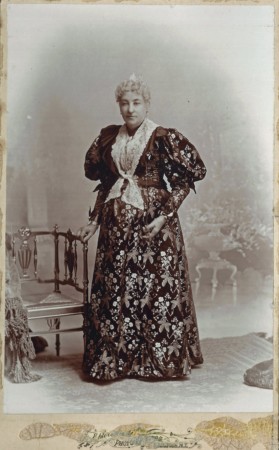Hannah Ambler: Leading by Example
Hannah Raymond Ambler was born at Ambler Farm in Wilton in December 1843. She is best known today as Betty Ambler’s grandmother.
Growing up in what is now the white house at Ambler Farm, Hannah had two older brothers, Charles and Henry, and two little sisters, Harriet and Elizabeth. Her father’s unmarried elder siblings, Jesse and Mehitable, lived on the farm, too, in what is now the yellow house. Even with the privileges of diverse land holdings and well above average wealth, life was hard. Harriet died in childhood and Charles passed away from a laudanum overdose as a young man. Henry may have been developmentally disabled and at some point lost a hand in a farming accident. Elizabeth remained unmarried, and Hannah nearly did, too.
Hannah was in her late twenties when Charles Augustus Ambler, a retail and insurance salesman, came along. Charles courted her and introduced her to his aunt, who thought that Hannah was “not young or very good looking” but still “a good suitable girl” for her nephew. The couple married in 1872 and had two boys, Lewis Raymond and Charles Meeker.
Hannah’s life comes into greater focus in the 1890s, when we have her scrapbooks, and after her husband’s death in 1897, when we have her diaries. Hannah’s scrapbooks show a woman deeply impressed by other women famous for their power and authority, as well as for their feminine grace, devotion to their spouses, and good motherhood. There are numerous clippings about Queen Victoria and presidential First Ladies, as well as anecdotes, stories, and poetry celebrating the sweetness, important work, and sacrifices of mothers like Hannah.
Hannah’s diaries show the yearly patterns of her life on Ambler Farm, setting red geraniums and potted palms out in the spring, cutting hay and preserving fruit in the summer and fall, butchering hogs, cutting ice, and working on her scrapbooks in the winter. Throughout it all, she continually worked to improve herself, writing out the definitions and pronunciations of new words she had learned, experimenting with writing left-handed, and laying out the details of the electoral college and how the 19th amendment might be ratified.
Besides keeping house and, after 1897, running the farm, Hannah and her sister Elizabeth managed the family’s finances and numerous rental properties. According to a diary entry in 1899, Hannah and Elizabeth were nothing less than the “power behind the throne.” It’s no surprise, then, that the sisters were active in the struggle to increase women’s power through suffrage.
Newspaper clippings in Hannah’s scrapbooks suggest she may have been thinking about voting and its importance as early as the 1870s or 1880s. But the first solid evidence of her interest in suffrage is an 1893 clipping, laying out Connecticut women’s newly won right and moral duty to vote on school matters. Underscoring her growing interests in government and power, Hannah and her sister attended President McKinley’s second inauguration in Washington, D.C., in 1901.
Hannah was also thinking about women’s property rights, education, and economic opportunities from the mid-1890s, when she and Elizabeth joined the Woman’s Central Association of Norwalk. As the club’s landlords at 47 South Main Street in South Norwalk, Hannah and Elizabeth would have joined in social activities, listened to educational talks, and helped run the club’s Woman’s Exchange, a shop where local, needy women could sell their handmade goods. Participation in the Woman’s Central Association and other clubs like the Daughters of the American Revolution ultimately linked Hannah and her sister into a larger network of active and influential “club women,” many of whom were suffragists.
Hannah and Elizabeth’s privileged position as landlords also gave them the power to make possible an early suffrage event in Norwalk. In 1910, the locally known suffragist Clara Hill gave a speech in front of an audience of 60 at the Pleasant Hour Theater, a property at 60 Wall Street owned by Hannah and Elizabeth. According to Clara’s nationally famous sister, Elsie, this was the “first popular Suffrage meeting in Norwalk.” Hannah and Elizabeth knew the Hill sisters through their mutual membership in several Norwalk clubs, including the Daughters of the American Revolution and the Norwalk Historical Society.
Hannah’s interest in suffrage grew in step with the nationwide revival in the movement’s energies in the early 1910s. She closely followed the activities of the Hill sisters and their colleagues in the Connecticut Woman Suffrage Association as they gave speeches throughout Fairfield and Litchfield counties. She wrote down suffrage facts, goals, and poetry in her diary. And soon, Hannah and her sister Elizabeth became active members of the Wilton Equal Franchise League, the Connecticut Woman Suffrage Association, and the National American Woman Suffrage Association.
During her lifetime, Hannah also supported the Wilton Library Association, local churches, and did her part for the nation during World War I. She died in 1925, after having voted in her first presidential election in 1920. Sadly, Hannah’s sister Elizabeth passed away a few years before national suffrage was won.






